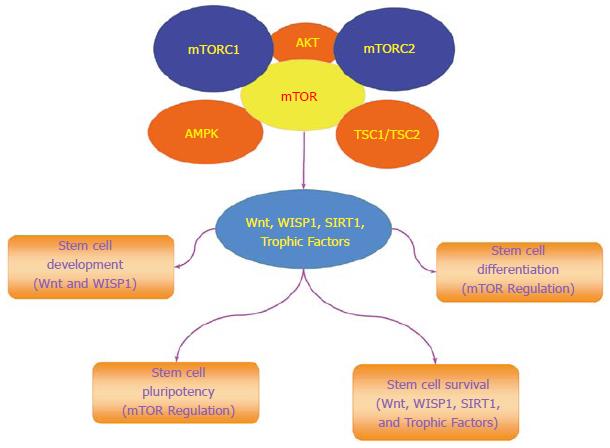Copyright
©The Author(s) 2015.
World J Stem Cells. Aug 26, 2015; 7(7): 999-1009
Published online Aug 26, 2015. doi: 10.4252/wjsc.v7.i7.999
Published online Aug 26, 2015. doi: 10.4252/wjsc.v7.i7.999
Figure 2 Mechanistic target of rapamycin governs stem cell development, pluripotency, survival, and differentiation.
The mechanistic target of rapamycin (mTOR), mTOR Complex 1 (mTORC1), mTOR Complex 2 (mTORC2), protein kinase B (Akt), AMP activated protein kinase (AMPK), and the hamartin (tuberous sclerosis 1)/tuberin (tuberous sclerosis 2) (TSC1/TSC2) complex each play a role in stem cell development and proliferation with downstream pathways. Stem cell maintenance and survival is reliant upon mTOR signaling pathways that work in concert with Wnt signaling, Wnt1 inducible signaling pathway protein 1 (WISP1), silent mating type information regulation 2 homolog) 1 (S. cerevisiae) (SIRT1), and trophic factors such as erythropoietin (EPO). Stem cell development is under the regulation of Wnt and WISP1. Regulation of mTOR can control stem cell differentiation and stem cell pluripotency. As a result, mTOR signaling pathways have oversight of stem cell development, pluripotency, survival, and differentiation.
- Citation: Maiese K. Stem cell guidance through the mechanistic target of rapamycin. World J Stem Cells 2015; 7(7): 999-1009
- URL: https://www.wjgnet.com/1948-0210/full/v7/i7/999.htm
- DOI: https://dx.doi.org/10.4252/wjsc.v7.i7.999









